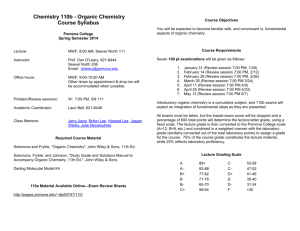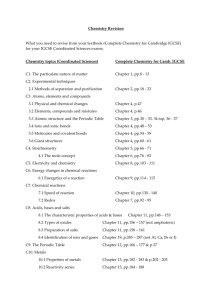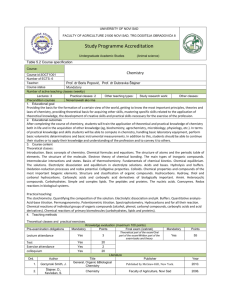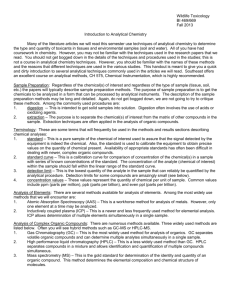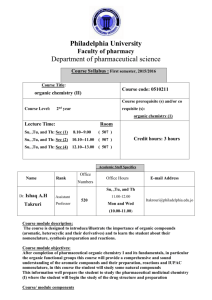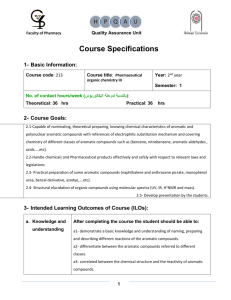HND Applied Chemistry MidKent College Title of the module Further
advertisement
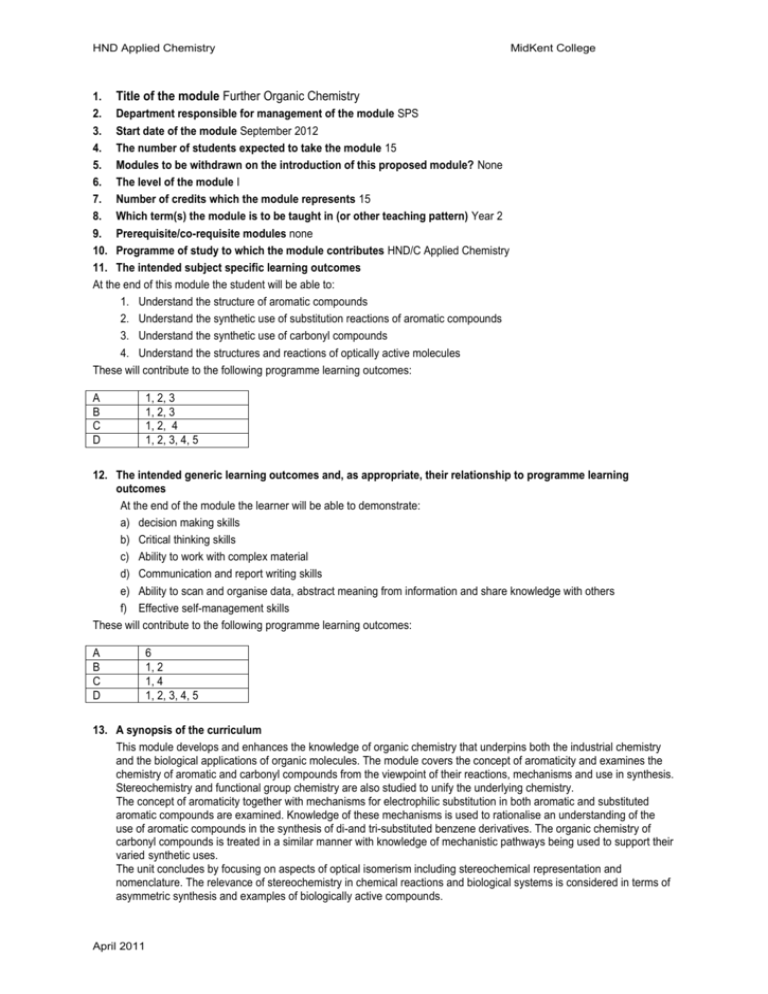
HND Applied Chemistry MidKent College 1. Title of the module Further Organic Chemistry 2. Department responsible for management of the module SPS 3. Start date of the module September 2012 4. The number of students expected to take the module 15 5. Modules to be withdrawn on the introduction of this proposed module? None 6. The level of the module I 7. Number of credits which the module represents 15 8. Which term(s) the module is to be taught in (or other teaching pattern) Year 2 9. Prerequisite/co-requisite modules none 10. Programme of study to which the module contributes HND/C Applied Chemistry 11. The intended subject specific learning outcomes At the end of this module the student will be able to: 1. Understand the structure of aromatic compounds 2. Understand the synthetic use of substitution reactions of aromatic compounds 3. Understand the synthetic use of carbonyl compounds 4. Understand the structures and reactions of optically active molecules These will contribute to the following programme learning outcomes: A B C D 1, 2, 3 1, 2, 3 1, 2, 4 1, 2, 3, 4, 5 12. The intended generic learning outcomes and, as appropriate, their relationship to programme learning outcomes At the end of the module the learner will be able to demonstrate: a) decision making skills b) Critical thinking skills c) Ability to work with complex material d) Communication and report writing skills e) Ability to scan and organise data, abstract meaning from information and share knowledge with others f) Effective self-management skills These will contribute to the following programme learning outcomes: A B C D 6 1, 2 1, 4 1, 2, 3, 4, 5 13. A synopsis of the curriculum This module develops and enhances the knowledge of organic chemistry that underpins both the industrial chemistry and the biological applications of organic molecules. The module covers the concept of aromaticity and examines the chemistry of aromatic and carbonyl compounds from the viewpoint of their reactions, mechanisms and use in synthesis. Stereochemistry and functional group chemistry are also studied to unify the underlying chemistry. The concept of aromaticity together with mechanisms for electrophilic substitution in both aromatic and substituted aromatic compounds are examined. Knowledge of these mechanisms is used to rationalise an understanding of the use of aromatic compounds in the synthesis of di-and tri-substituted benzene derivatives. The organic chemistry of carbonyl compounds is treated in a similar manner with knowledge of mechanistic pathways being used to support their varied synthetic uses. The unit concludes by focusing on aspects of optical isomerism including stereochemical representation and nomenclature. The relevance of stereochemistry in chemical reactions and biological systems is considered in terms of asymmetric synthesis and examples of biologically active compounds. April 2011 HND Applied Chemistry MidKent College 14. Indicative Reading List Smith MB and March J – March’s Advanced Organic Chemistry – 5th Ed (Wiley, 2001) ISBN 0471585890 Browne, Foote and Iverson – Organic Chemistry 4th Ed (Thompson Brooks/Cole) ISBN 0-534-39597-X McMurry – Organic Chemistry 7th Ed (Thompson Brooks/Cole) ISBN 978-0-495-11628-8 Clayden, Greeves, Warren and Wothers- Organic Chemistry (Oxford University Press ) ISBN 978-0-19850346-0 Burrows et al; Chemistry3; Oxford University Press; ISBN 978-0-19-927789-6 Websites: Royal Society of Chemistry 15. Learning and Teaching Methods, including nature and number of contact hours and total study hours which will be expected of students, and how these relate to achievement of the intended learning outcomes The total learning time for the module will be 150 hours. The module will be delivered by means of lectures, seminars, and practical work. Learners will be expected to undertake approximately 90 hours of independent study, including research, required reading and answering assignments. There will be 32 one hour lectures, 4 one hour supervision/problem sessions one per learning outcome and 8 half day laboratory sessions (total 60 hours). This will include a variety of tasks, discussions, study materials and case studies, practical’s, as appropriate to the topics being covered, with the focus being on the learning outcomes. 16. Assessment methods and how these relate to testing achievement of the intended learning outcomes Laboratory practical reports and questions 20%(learning outcomes 1-4, generic outcome d,e and f) Problems for each learning outcome 20% (learning outcomes 1-4, generic outcomes a, b and c) Coursework 60% (learning outcomes 1-4, generic outcomes a to f) Learning outcome To achieve this outcome a student must demonstrate the ability to: Understand the structure of aromatic compounds explain the structure of benzene in terms of delocalized p system and molecular orbitals review experimental evidence to support current model of benzene structure categorise hydrocarbon and heterocyclic structures as aromatic or anti-aromatic using Huckel’s rules analyse experimental data to elucidate structures of aromatic compounds Understand the synthetic use of substitution reactions of aromatic compounds explain, using mechanisms, specific electrophilic substitution reactions explaintheeffectofsubstituentonelectrophilicand nucleophilic Understand the synthetic use of carbonyl compounds April 2011 reactivity of substituted benzenes discussdifferentsyntheticpathwaysforthesynthesisof substituted benzene compounds explaintheimportanceofaromaticcompoundsina commercial context review acidity of carbonyl compounds in enolisation and explain the role of aldol reactions in synthesis discuss the synthetic role of ester enolate condensation reactions explain alkylation of ester enolates in a synthetic context discuss synthetic pathways using conjugate addition reactions HND Applied Chemistry MidKent College Understand structures and reactions of optically active molecules explain (+) (-) and R/S notation and calculate optical rotations using given data explain the resolution of enantiomers discuss the properties of diastereoisomers use Fischer stereochemical representations for R/S enantiomers discuss reactions involving optical activity and the importance of optical activity in biological systems 17. 18. Implications for learning resources, including staff, library, IT and space This is an existing module and there are no new implications for learning resources. As far as can be reasonably anticipated, the curriculum, learning and teaching methods and forms of assessment do not present any non-justifiable disadvantage to students with disabilities Statement by the Director of Learning and Teaching: "I confirm I have been consulted on the above module proposal and have given advice on the correct procedures and required content of module proposals" ................................................................ .............................................. Director of Learning and Teaching Date Statement by the Head of Department: "I confirm that the Department has approved the introduction of the module and will be responsible for its resourcing" ................................................................. Head of Department April 2011 .............................................. Date
